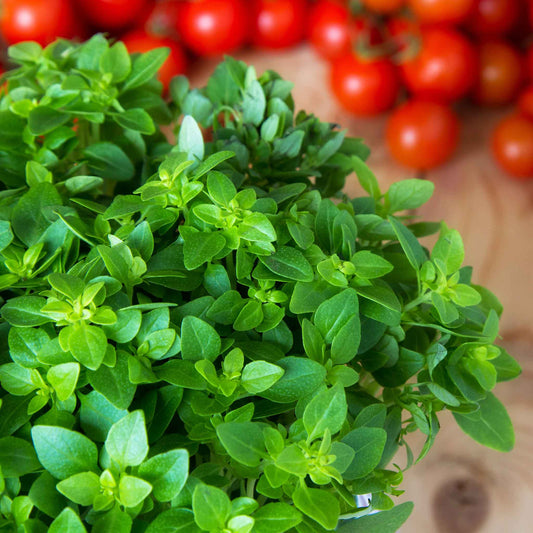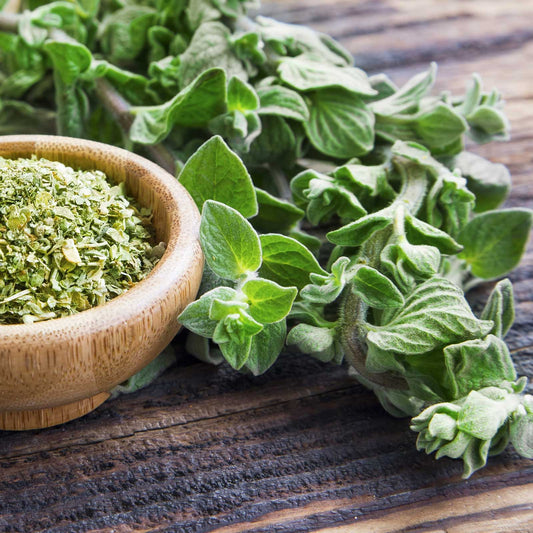-
main-collection-product-grid

Oregano Seeds (Organic) - Italian
Larger leaves for drying, versatile and deliciousOregano Seeds (Organic) - Italian
Larger leaves for drying, versatile and deliciousRegular price $8.99Regular priceUnit price per -
main-collection-product-grid

Oregano Seeds (Organic) - Greek
Used in Italian and Greek recipes, thrives in dry soilOregano Seeds (Organic) - Greek
Used in Italian and Greek recipes, thrives in dry soilRegular price $8.99Regular priceUnit price per
What we love about growing organic oregano
- Perennial herb that thrives in full sun and poor soil
- A favorite for companion planting with other vegetables
- An intense aromatic herb, with a slightly bitter taste
- Attracts native pollinators and beneficial insects
The best organic oregano for flavorful dishes
Oregano may be one of the most versatile culinary herbs. Delicious in everything from Italian pasta to Mexican dishes to Greek cuisine, oregano should definitely have a place in your herb garden, and perhaps even your cutting garden!
This Mediterranean native blooms in beautiful hues of white, pink, and purple. While oregano typically isn't allowed to flower if used in cooking, If you let a few of your plants bloom, the budding foliage could be the perfect filler for summer bouquets. Have a sandy spot in your yard that won't grow grass? Try sowing some oregano seed—this hardy herb is happy to take over as fragrant ground cover. Organic oregano makes an incredible companion plant to several vegetables, including Brassicas and beans. Not only does organic oregano work as a natural pest repellent, but the herb attracts native pollinators and beneficial insects as well!
How to plant organic oregano seeds
Start organic oregano seeds indoors at least six weeks before the last frost, or direct sow seeds immediately after the last frost. When the seedlings have developed strong taproots, transplant seedlings outside and space them eight to twelve inches apart. Direct sow seedlings outside at around the same spacing. Organic oregano benefits from a process called pinching—as counterintuitive as it sounds, you’ll want to go through after seedlings are at least four inches and cut off the tips. Pinching encourages plants to branch out, making a more abundant harvest come summer. The most flavorful leaves appear on the plant right before it flowers—so for best culinary results, pinch budding stems so the plant will continue to produce flavorful leaves. Keep your oregano plants close to the kitchen and harvest fresh leaves as you need them.
Drying organic oregano
To dry organic oregano in bulk, cut the stems when they are at least six inches tall, cutting above a node (or set of budding leaves) to ensure that your oregano will keep producing. Bunch the stems together, hang upside down in a cool, dry place, and allow to dry for several weeks. Organic oregano leaves hold their flavor when dried, making this an easy spice to store.
In addition to its status as an essential culinary herb, organic oregano is also used medicinally. Oregano essential oil can be applied topically or taken orally. Oregano works as an anti-inflammatory agent and is useful in easing joint pain. The herb also has antibacterial and even antiviral properties. If the flavor alone isn’t enough to entice you to grow organic oregano in your garden this year, maybe this herb’s medicinal properties will. If nothing else, plant this deer-resistant perennial to protect the other plants in your garden!
For more information about planting, growing, and harvesting organic oregano seeds, see the Oregano Seeds Planting Guide.

